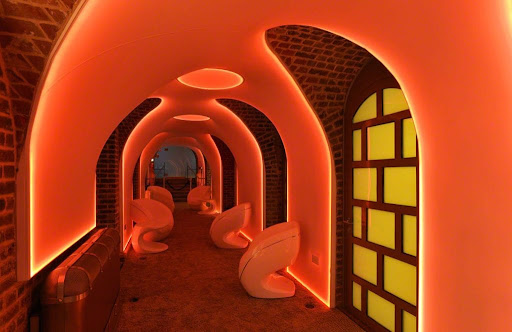
According to the latest research, the global wellness tourism market size was valued at $814.6 billion in 2022 and is expected to grow at a rate of 12.42% from 2023 to 2030.
Having experienced a particular boost in popularity since the 2020 pandemic, when people around the globe were forced to rethink how we live, work and travel, wellness tourism focuses on preventing diseases and emphasising a healthy lifestyle.
This is music to the ears of hospitality venues with a spa and wellness space. It provides a huge opportunity for those looking to elevate their treatments and experiences by introducing wellness tech and holistic healing, amongst other top trending offers.
From immersive spa journeys to light therapy and sustainable wellbeing design, we’ve picked out the top spa industry trends this year and explained how to incorporate them into your spa’s interior design.
The top 4 latest spa trends for hotels this year
1. Incorporate wellness technology into the spa experience
During the pandemic, the spa and wellness world was rocked by a tech disruption as people were forced to continue their health and wellbeing routines virtually. And while life has gone back to normality in most cases, wellness tech is here to stay.
Wellness tech allows spas to offer guests new ways to experience healthy lifestyles that they may previously not have had the space, accessibility and know-how for, such as cryotherapy lounge chairs and meditation pods.
While gas cryotherapy and cold baths have been around for a while, neither were particularly practical to offer in confined wellness spaces. Through the introduction of cryo lounge chairs, guests can now enjoy the benefits of cryo chambers while sitting on a lounger fully clothed, allowing for a convenient and more ‘comfortable’ wellness solution. Targeting specific areas of the body to deliver the benefits of cold and heat, cryo lounge chairs offer a hassle-free set-up and operation that will allow you to make an additional revenue stream if offered as a premium solution.
In a similar fashion, meditation pods provide a relaxing and stress-reducing alternative to spas that have previously been unable to incorporate entire rooms dedicated to the practice. Designed to create moments of calm, meditation pods offer unique, multi-sensory experiences to help guests unwind from the stresses of daily life. They come in many shapes and sizes and are integrated with guided meditations, music, lighting and aromatherapy to create a fully immersive experience your guests will not forget.
2. Create an immersive spa journey for your guests
Another top trend that has been growing in popularity over the years is the rise of immersive spas. Designing a spa to provide an immersive experience will allow you to help reduce stress and promote wellbeing for your guests like never before.
Immersive spas offer multisensory experiences that catapult guests into a different environment. Think floor-to-ceiling visuals that flawlessly incorporate the right light, sounds and scents to improve the overall wellbeing of guests depending on the treatment or practice they are engaging in.
Imagine offering the sounds, smells and visuals of a calm beach morning while your guests enjoy a yoga class. Or transporting them into the zen of a green forest during a therapeutic massage session. Take a read of our article on the future of immersive experience design to learn more about the wellbeing benefits of multisensory wellness spaces.
3. Embrace holistic forms of spa treatments for mind and body
McKinsey’s 2021 survey on the future of the $1.5 trillion wellness market found a substantial global increase in the prioritisation of wellness over the past two to three years. Defining ‘wellness’ as a way to incorporate better physical and mental health, fitness, nutrition, appearance and sleep, they found an increase in demand for holistic services as an enhancement of personal wellbeing.
These treatments come in a range of shapes and sizes, but think crystal healing massages, sound baths and light therapy facials, which all have a range of health benefits using energy, music and light to facilitate healing.
From a design perspective, you’ll want to provide holistic treatments in a quiet space, ideally with natural light and a scenic view. Minimalist design incorporating natural materials and decor work best to create the zen vibes that will allow guests to switch off completely.
4. Add a sustainable touch to your spa’s interior design
2023 has been called a ‘pivotal year for sustainability’ as a new level of seriousness around sustainability across companies and consumers will hold more brands accountable and set the stage for proof-driven change. According to new NielsenIQ survey data, almost 50% of consumers are looking to brands to take the lead on creating sustainable change.
This doesn’t just hold true for the products they buy but also for the services they select and the environments they choose to be in. As a forward-thinking hotel, you can make a conscious and committed effort to minimise your spa’s negative impact on the environment. This can be done by reducing waste, using renewable or recycled materials and minimising the consumption of non-renewable resources.
When looking for more sustainable materials to build your spa, there are a number of popular choices available including bamboo carpets, recycled plastic floors and non-toxic clay-finishing wallpaper. Learn more about sustainable materials in our recent article Sustainable Interior Design: Examples Within the Wellness Industry.
The Future of Wellness Design: download our ebook
With over two decades of experience in the wellbeing industry, we’ve been ahead of global spa design trends for years.
In our latest ebook, The Future of Wellness Design, we look at the difference between wellness and fitness, the role that wellness plays in maintaining positive mental health and the growing trend in adopting a more holistic approach to physical and mental wellbeing.
We then discuss what this means for hospitality businesses, and look at different spaces hotels can build to incorporate wellness design. We’ve also added a case study as an example and included information on what working with professional wellness designers looks like.



